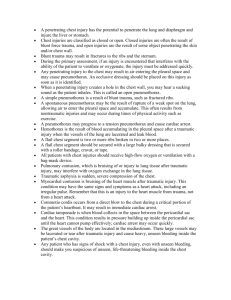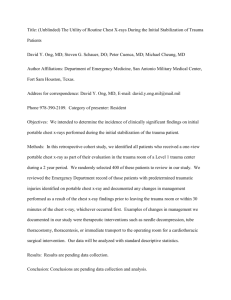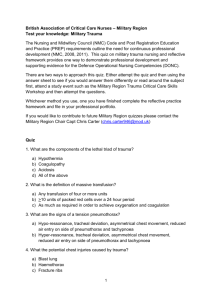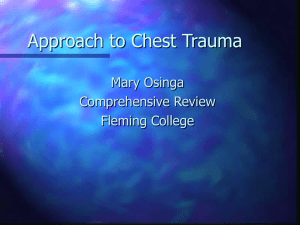Thoracic_Trauma
advertisement
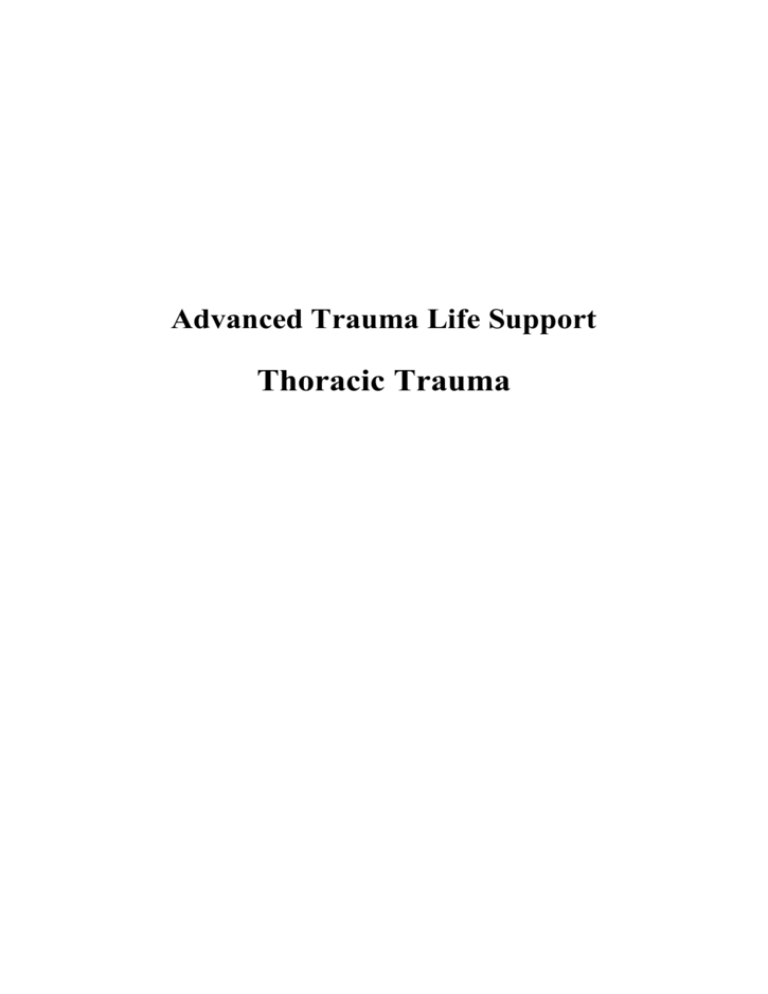
Advanced Trauma Life Support Thoracic Trauma Objectives A-Identify and manage the following immediately life-threatening chest injuries evidenced in the primary survey: 1.Airway obstruction 2.Tension pneumothorax 3.Open pneumothorax (sucking chest wound) 4.Massive hemothorax 5.Flail chest 6.Cardiac tamponade B-Identify and initiate treatment of the following potentially life-threatening injuries assessed during the secondary survey: 1.Pulmonarycontusion 2.Aortic disruption 3.Tracheobronchial disruption 4.Esophageal disruption 5.Traumatic diaphragmatic hernia 6.Myocardial contusion Chest Trauma 1 out of 4 deaths Thoracic Injuries 85% Require : *Correct hypoxia *Improve circulation *Alleviate ventilatory obstruction Etiology of Hypoxia *Hypovolemia tissue hypoxia *Perfusion unventilated lung *Ventilation of unperfused lung *Abnormal pleural airway relationships Primary Survey Life threatening chest trauma *Airway *Breathing *Circulation Tension Pneumothorax *Air enters pleural space without exit *Collapse of affected lung *Impaired ventilation-unaffected lung *Mechanical ventilation with PEEP *Nonsealing *Emphsematous bullae lung injury *Tracheal deviation *Respiratory distress *Unilateral absence of breath sounds *Distended neck veins *Cyanosis-late Treatment *Immediate decompression *Clinical diagnosis not radiologic Open Pneumothorax Management *Immediate covering of defect *Chest tube *Definitive operation Massive Hemothorax *1500 ml + blood loss *Systemic of pulmonary vessel disruption *Flat vs. distended neck veins *Shock / no breath sounds or percussion dullness Management *Rapid volume restoration *Chest decompression & X-ray *Auto-transfusion *Operative intervention *Re-expand lung *Oxygen *Judicious fluid management *Selective intubation *Analgesia Classic Findings *Narrowed pulse pressure *Elevated CVP *Muffled heart sounds *Distended neck veins Management *Patient airway *IV therapy *Pericardiocentesis *Open thoracotomy with repair Secondary Survey *In-depth physical exam *Upright chest film *ABGs *ECG *Pulmonary contusion *Aortic disruption *Tracheo-bronchial injury *Myocardial contusion Pulmonary Contusion *Most common *Selective intubation & ventilation *Maintain adequate oxygenation Major Intrathoracic Vascular Injury *90% fatal at scene *50% mortality each day treatment delayed *Common sit: ligamentum arteriosum Widened Mediastinum On X-ray Management *Direct repair *Resection & graft *Treatment by qualified surgeon Tracheal Injuries *Penetrating:♦STAT surgical ♦repair ♦Associated Blunt:♦Subtle ♦History ♦Important Laryngeal Fractures *Hoarseness *Subcutaneous emphysema *Palpable fracture creptius Tracheal Injuries *Partial vs. complete airway obstruction *Endoscopy-diagnostic aid Bronchial Injury *Frequently missed *Blunt trauma *50% of deaths in 1 hour Management *Airway maintenance *Surgical intervention Esophageal Trauma *Blunt vs. penetrating *Severe epigastric blow *Pain/shock, injury *Pneumo/hemothorax without fracture Esophageal Trauma *Chest tube-particulate matter *Chest tube-bubbles continuously *Mediastinal air/empyema *Gastrografin swallow/esophagoscopy Management of Surgical Intervention Traumatic Diaphragmatic Hernia *Diagnosed left side *Blunt: large tears *Penetration: small perforation *Misinterpreted X-ray *Contrast radiography Myocardial Contusion *Blunt trauma *History *ECG changes *Serial enzyme changes *Treatment: observe/monitor Subcutaneous Emphysema *Airway injury *Pneumothorax *Blast injury Pneumothorax *Blunt trauma *Ventilation/perfusion defect *Hyper-resonance *Decreased breath sounds *Treatment- tube thoracostomy Hemothorax *Etiology ♦Lung laceration ♦Vessel laceration *Treatment ♦Tube Thoracostomy for continued bleeding Rib Fractures *Pain/splinting *Impaired ventilation *Increased secretions *Atelectasis/pneumonia Ribs # 1-3 *Severe force *Associated injuries *50% mortality Ribs # 5-9 *Majority - blunt trauma *Bowing effect *Midshaft fracture *Intrathoracic Management *Obtain chest X-ray *Avoid ♦Systemic analgesics ♦Constrictive devices Indications for Chest Tube Insertion 1. Pneumothorax 2. Hemothorax 3. Selected cases, suspected severe lung injury 4. Prophylaxis Summary *Common in multiple injured patient *Cognitive knowledge to diagnose *Develop skills *ECG monitoring Pitfalls in Thoracic Injuries *Failure to obtain a chest X-ray soon after admission and again within 4-8 hours may result in significant intrathoracic injuries being overlooked *Excessive reliance on chest X-rays may lead to diagnostic errors *Without careful inspection of the chest wall, contusions, flail chest, intrathoracic bleeding, and open or "sucking" chest wounds may be overlooked *A fractured sternum can be easily missed unless the sternum is palpated carefully or special X-ray views are obtained *Cardiac arrest may occur suddenly and rapidly if there is any delay in relieving a suspected tension pneumothorax in a hypotensive patient. X-rays are not needed before treatment under such circumstances *Inserting a chest tube while the patient is lying flat increases the chances for injury to the diaphragm *If an air leak and pneumothorax space are allowed to persist together, the patient is apt to develop an empyema or bronchopleural fistula *If a patient with multiple injuries which include a flail chest is not given ventilatory assistance with a respirator soon after admission, he is apt to die of respiratory failure *If a diaphragmatic injury is not suspected and looked for in all patients with chest trauma, the diagnosis will probably be missed *If it is assumed that bleeding from the chest wound in a hypotensive patient is superficial in origin, the diagnosis and treatment of severe intrathoracic bleeding may be delayed *Repeated attempts to completely aspirate a small hemothorax with a needle or a syringe may cause a pneumothorax or empyema *Use of high ventilatory pressures to inflate the lungs following penetrating chest wounds may result in systemic air emboli *Failure to obtain an aortogram when there is superior mediastinal widening following blunt chest trauma may result in an inaccurate diagnosis and an unnecessary thoracotomy *Hypotension following blunt chest trauma is frequently due to intra-abdominal bleeding *Delay in closure or drainage of esophageal injuries result in a high morbidity and mortality; hence, early diagnosis and treatment are vital *Any delay in providing adequate ventilatory support greatly increases the risk of irreversible respiratory failure *Excessive administration of crystalloids greatly increases the risk of respiratory failure *Failure to empty the stomach with a tube soon after chest trauma greatly increases the risk of aspiration and severe ileus

